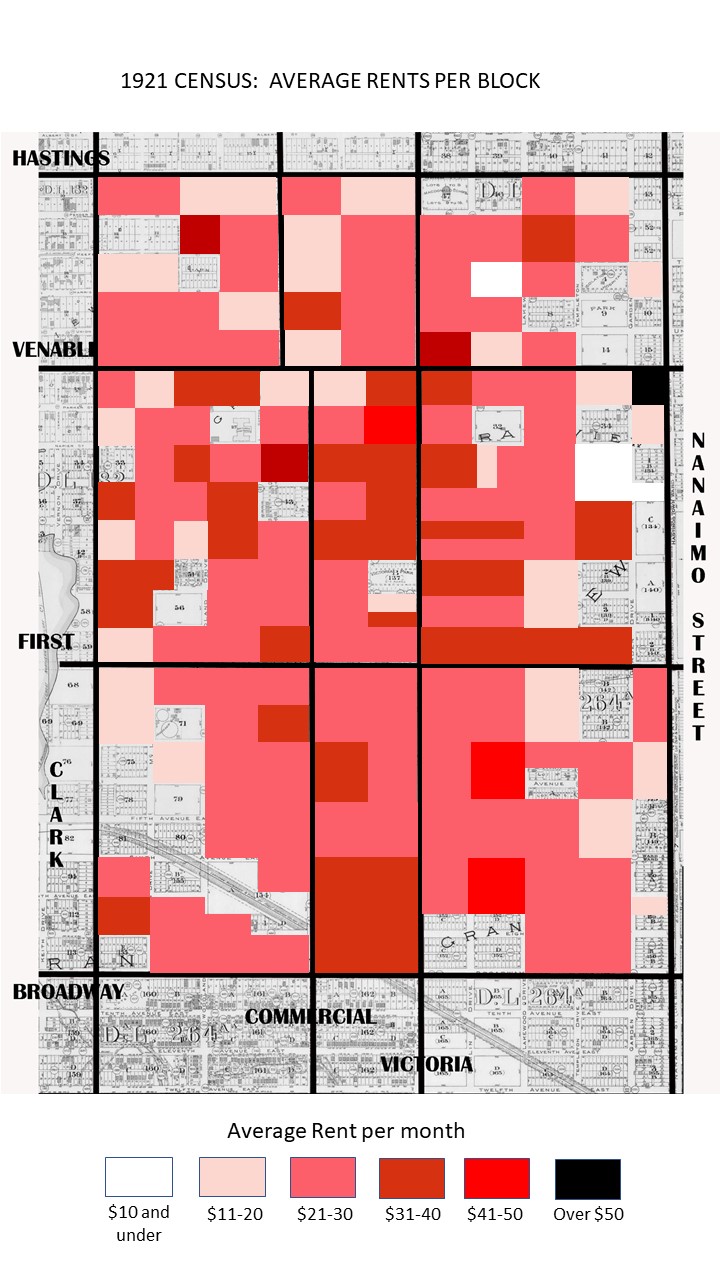An innovation of the 1921 Canada Census was to ask detailed questions regarding those who rented, how much rent they paid, and how many rooms they occupied.
According to the 1921 Census counts, in the core district of Grandview, there were:
- 4,547 people living in rental accommodation, or 44.27% of the Census population;
- They were living in 1,191 suites and houses, comprising 5,341 rooms;
- The average rental unit contained 4.5 rooms, with
- an average of 3.82 people per unit, and
- an average of 0.85 persons per room;
- The average rent was $26.75 per month and
- the median rent was $25 per month;
- Rents ranged from $5.00 to $75.00 per month;
- Total rents brought in $31,861.50 per month;
I have used this data to show how rentals as a percentage of overall population were distributed across the district.
The map shows that the highest concentrations of renters were in the north-west half of the district, while properties east of Victoria were more generally occupied by owners.
The data also allows us to see where average rents per block were higher or lower:
The pattern here is not so clear, although the less expensive rents were generally along the western, northern, and eastern periphery.
The least expensive rents, at $5 per month, were both in 2-room shacks, one at 1812 E. Pender and the other at 1224 Garden Drive. Besides those, 1365 E. Georgia — which in 1911 had been a $1 a week flophouse — was the next cheapest option offering 20 two-room units at $6 and $7 a month.
The most expensive suites were at 841 Commercial and 1000 Commercial. In the former, furniture dealer Ada Walsh and her three children occupied an 8-room suite at $75 per month. In the latter, Dr. Sutherland and his family lived in a 7-room suite for the same price. (As an aside, I will note that Mrs. Walsh claimed on the census form to have earned $1,000 in the previous 12 months, while paying $900 in rent).
The apartment building at 841 Commercial, the Sandon Apartments, offers a good opportunity to see what variety was available. While Mrs. Walsh paid $75 a month, most of the suites listed in the census were significantly less — ranging from 1- and 2-room suites at $10 and $12 through to 4-rooms at $20, $22.50, and $25 a month. The owners of the building were frequent rental advertisers and during 1921 they offered 3- and 4-room furnished housekeeping suites at $22 and $25, with a 2-room unit at $12 a month.
Vancouver Sun, 7/13/1921, p.10

Vancouver Sun, 10/28/1921, p.10
Finally, I believe the actual number of renters is under-counted in the Census. There are significant numbers of people listed as “boarders”, “roomers”, or “lodgers” who are shown as distinct from those who were officially renting. Because neither rental amounts nor the number of rooms they occupied are shown in the Census, I have not counted them in my survey. However, I assume that at least some of these people were contributing to the household expenses and were, in all but name, renters.



Very interesting research. Did you uncover any comparisons to how our neighbourhood is being lived in today? Are there just as many rentals, rental as a percentage of income etc? People always say it’s more expensive to live here, but I wonder is it all relative? Thanks for sharing!
LikeLike
Hi there. Thanks for the question. I have not made a study of the 2016 half-census results, but I seem to recall that renters were about 55% of the population in the (somewhat different) census area covered by my research. Again from memory, that was slightly down from the 2011 census (though I could be wrong about that). I have no current data on rents other than what I read in the media (and what my own landlord charges!).
LikeLike